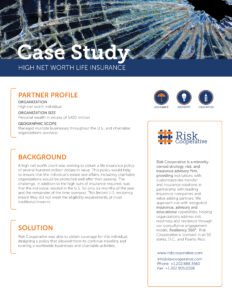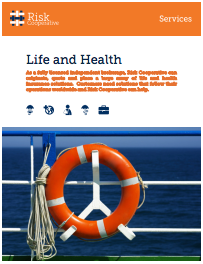Insurance Solutions
Private Client Practice
The lines between risk and reward have blurred, as have the lines between private wealth and enterprise/portfolio value.
Our private client experience brings a comprehensive advisory, risk management and risk transfer capability to high net worth individuals. Our team provides a cost effective and stable approach to reduce uncertainty across personal risks, tangible and intangible assets, reputational harm, privacy, as well as wealth preservation and succession. Offering integrated, concierge-style risk advisory, insurance and risk-transfer across all asset classes, our Private Client Practice provides peace of mind worldwide to thousands of discerning risk-aware individuals.
Key Coverages:
- Motor
- Property
- Fine Art
- Museums and exhibitions
- Jewelry
- Travel
- Aviation
- Estate
- Equine
- Yacht
Insurance Solutions
Private Client Practice
The lines between risk and reward have blurred, as have the lines between private wealth and enterprise/portfolio value. Risk Cooperative and RCM&D have partnered to offer a reimagined private client experience that brings a comprehensive advisory, risk management and risk transfer capability to high net worth individuals.
Our team provides a cost effective and stable approach to reduce uncertainty across personal risks, tangible and intangible assets, reputational harm, privacy, as well as wealth preservation and succession. Offering integrated, concierge-style risk advisory, insurance and risk-transfer across all asset classes, our Private Client Practice provides peace of mind worldwide to thousands of discerning risk-aware individuals.
Key Coverages:
- Motor
- Property
- Fine Art
- Museums and exhibitions
- Jewelry
- Travel
- Aviation
- Estate
- Equine
- Yacht
Resource Library
While one of the main criticisms of cryptocurrencies is their use in crime, particularly financial evasion and ransomware payments, crypto criminality appears to be taking a new violent turn. The high-profile kidnapping in Norway of Anne-Elisabeth Falkevik Hagen, billionaire Tom Hagen’s wife, on October 31, 2018 has yielded few clues and confounded law enforcement officials. […]
While one of the main criticisms of cryptocurrencies is their use in crime, particularly financial evasion and ransomware payments, crypto criminality appears to be taking a new violent turn. The high-profile kidnapping in Norway of Anne-Elisabeth Falkevik Hagen, billionaire Tom Hagen’s wife, on October 31, 2018 has yielded few clues and confounded law enforcement officials. Her abductors have demanded a ransom of approximately $10 million payable in the lesser known cryptocurrency monero (market cap $735 million), raising the specter of more organized personal threats where the relatively low traceability of cryptocurrencies makes them the thrift of choice for ne’er-do-wells. This case also signals a shift away from bitcoin, which has more robust crime fighting tools, towards alternate cryptocurrencies, where criminals have more than 1,600 cryptocurrencies to choose from.
The Norwegian police made this case public due to the lack of clues on Mrs. Hagen’s whereabouts and the lack of evidence or proof of life, which is one of the tell-tale signs of a negotiable kidnapping. Norway has been gripped by this unfortunate event, not only for the unusual nature of the case, but for the crime itself, which is incredibly rare in Scandinavia. This is not the first time there is a demand of a ransom payment or coercion in cryptocurrency. However, the process and demand for crypto ransoms have historically been reserved for what security professionals call “express kidnappings.” As the name suggests, an express kidnapping is a short term, if violent, curtailment of an individual who is released on the payment of lower sums of ransom money or cryptocurrencies typically paid directly by the victim. When express kidnappings first emerged, victims were taken on rides to various ATM machines, until they could withdraw their maximum daily limits. Thereafter, they were typically let go with bumps and bruises, but alive.
Since the advent of bitcoin 10 years ago (the most widely circulated and best known cryptocurrency), express kidnappings and physical coercion have been a part of the tradeoff individuals have had to contend with by making themselves a veritable bank. It would stand to reason that with the advent of entirely decentralized banking and wealth creation, the onus of “hardening” a target would shift from institutions like banks to individuals. Crypto holders have since gone to great lengths to protect their crypto wealth from threats real and virtual. The Norwegian case, however, along with a recent case in Costa Rica, which netted 12 arrests in an organized kidnapping ring, suggests that comparatively petty crypto crime and physical violence may be getting more organized and moving up-market, even targeting individuals who have no crypto assets themselves.
What these cases also suggest is that insurers, such as providers of kidnap and ransom protection, may want to quickly orient themselves and perhaps even have a store of cryptocurrencies to facilitate ransom payments. Just as cyber crime developed veritable customer service standards, particularly with ransomware payments, which yield a greater than 90% recovery rate for certain sectors, commercially oriented kidnappings can end positively. The scourge of economically motivated kidnappings has similarly been abated through skilled negotiators, operating norms such as proof of life, and successful recoveries based on the victims and their loved one’s compliance and crisis response capabilities. Adding a dimension of technological or digital literacy to this challenge, such as demands for millions in monero, bitcoin or other cryptocurrencies, which appears to be on the ascendant, will only complicate matters for families, law enforcement and crisis responders.
These cases, furthermore, will continue to blunt broad market adoption of cryptocurrencies, where most of the world’s regulators are still on the sidelines of the asset class. Meanwhile, the enhanced traceability of major cryptocurrencies, such as bitcoin, down to the micropayment level, is aiding law enforcement and perhaps even shifting criminality down to lower circulation alternatives. Indeed, monero, has been on FBI watch lists for this very possibility for some time now. High net worth individuals have always had to contend with personal security risks and the blurred lines between private and institutional wealth. Adding in a new potential barrier of technical literacy with cryptocurrencies as a means of thrift may only complicate matters and add to the unique risks posed by this asset class.
As the Norwegian drama unfolds and enters its fifth month without resolution, one can only hope for the safe return of Mrs. Hagen. A glimmer of hope has been provided through recent communications with the suspected kidnappers, but so far, no proof of life has been given and few leads have been secured by law enforcement, hence their appeals for public support. Law enforcement, high net worth individuals (particularly the crypto nouveau riche) and insurers should take special note of how this case unfolds. Like with all crime fighting and risk management, you must be right 100% of the time and the threat must be right once.
For the world’s elite, what bankers and financial services providers refer to as private clients, the mass affluent or the ultra-high net worth, the lines between their personal wealth, assets and liabilities, and those of their underlying business interests have blurred. Indeed, as Elon Musk’s $40 million tweet recently illustrated, this segment cannot easily shield […]
For the world’s elite, what bankers and financial services providers refer to as private clients, the mass affluent or the ultra-high net worth, the lines between their personal wealth, assets and liabilities, and those of their underlying business interests have blurred. Indeed, as Elon Musk’s $40 million tweet recently illustrated, this segment cannot easily shield their personal, enterprise or family office wealth from adverse market responses. Add in the effects of rising populism, born in part from severe income inequality, and it is not inconceivable to see hoards with torches and pitchforks demanding retribution or, at a minimum, redistribution.
Negative market and popular sentiments aside, the concentration of wealth in the hands of business, investment and entrepreneurial leaders is one of the principal engines driving philanthropic activities around the world. This is so because the mass affluent do not need to form large committees plagued by analysis paralysis to support causes and projects they care about. While the very pointy end of the market, with the likes of Warren Buffet, Bill and Melinda Gates, Susan Powell Jobs and Jeff Bezos, who has recently pledged $2 billion to combat homelessness, capture headlines, the well to do generally aim to do good with their money. Therefore, taking a more active stance on wealth preservation beyond managing market risk, which their investment managers and wealth advisors are charged with, requires a recognition that the personal risks arrayed against them are changing.
Managing the risk of a millionaire or billionaire is neither retail nor run of the mill. Indeed, the portfolio of assets, liabilities, investment interests, along with a global travel footprint exposing loved ones to a turbulent (if affluent) world, is more akin to managing enterprise risks than personal ones. This market gap is not lost on the uppermost echelons of the affluent, who often hire personal security details, travel in armored convoys, private aircrafts, yachts and helicopters to not only avoid the inconveniences of mass transit but to avoid the potential dangers, which are very real. In Tanzania Africa’s youngest billionaire, Mohammed Dewji with an estimated net worth of $1.5 billion, was kidnapped earlier this month and held during a 9 day ordeal. Surely a crisis management and response team were mobilized in this harrowing situation, which can potentially expose millions in financial costs – if the kidnappers are willing to settle financially – as well as levying a more severe personal and emotional toll. Indeed, even superstars for whom the lime light is as attractive as a moth to a fire are not spared this scourge. Kim Kardashian’s 2016 jewelry heist in a swank Paris hotel in which thieves absconded with $10 million worth of jewels, reveals that no one is invulnerable. Like with all risks, prevention is better than cure.
As more desirable wealthy targets harden their physical security posture, the personal risk of kidnappings went “down market,” giving rise to express kidnappings and other low-grade threats on so-called soft targets. However, the ultra-wealthy, especially the crypto nouveau riche, whose bitcoin billions are often in the care, custody and control of shoddy digital wallets, physical keys or exchanges, for whom tight cybersecurity standards are the exception rather than the rule, risks are on the rise. From social engineering, to spoofing, phishing or “whaling” scams, which deliberate target easily identifiable prey, have cost this segment billions in evaporated wealth. Here too the peril of cyber ransom and extortion is very real, including the growing specter that cyber criminals hack into online devices to retrieve sensitive information. This includes gathering lascivious online behavior with the threat of exposure in exchange for payment or action, which is more plainly referred to as “sextortion.” Like with hardening a personal security posture, here too, prevention is better than cure, and the need for a standby digital fire brigade to help remediate, manage crisis response and shelter wealth are all in order.
Protecting property in an increasingly volatile world, roiled by the twin-threats of climate change and financial capital in retreat, is not only costly for the world, it is particularly costly for the well-heeled. The blessing of beach front property, a private yacht or a log cabin abutting a century’s old forest in a world etched by climate extremes is quickly becoming a curse. Sir Richard Branson’s private Island, Necker, was completely devasted by Hurricane Irma in 2017, resulting in an upwards of $50 million insurance claim. Similarly, coastal properties from the Florida Peninsula, across the Caribbean, to California and Hawaii, which have had record fires and volcanic eruptions, property losses are mounting while traditional insurance options are in retreat. Meanwhile, the propensity to acquire rarity, even if it is on auto-destroy, whether in the form of art, objects or toys, is also becoming increasingly difficult to shield and insure. This is so because insurers are facing real stressors in their own asset-liability management activities, who like the high-net worth, are finding that many of them are not only too big to fail, they are also too big to hide.
For people in the pursuit of wealth and the lifestyle and differences it affords, the well to do would say that money is not a pursuit it is an outcome. Many of the entrepreneurs and mass affluent around the world are self-made with inspiring stories and legacies they aim to leave behind, whether in their businesses, which often employ thousands of people, or through their philanthropic efforts. For this, the hardest challenge is often succession, preservation and perpetuation as they contemplate how wealth is shielded and stewarded for future generations. Indeed, the world-changing work of the Rockefeller or Gates foundations would not be possible without the direct linkage between enterprise wealth, private wealth and philanthropic activity. Down market from these titans, the same general dilemma holds true for individuals or family offices, which act as a veritable family sovereign wealth fund for wealthy individuals.
Today the risk management lines, insurance relationships and assurances provided between these identities and wealthy patrons are not interoperable, which can prove to be very costly indeed. Tesla is rightly worried about succession planning for an increasingly wayward Elon Musk who is beyond the control of the board and beyond the reproach of even the SEC, which would send corrective shivers down the spine of any other public company leader. Here too, managing market risk alone, through asset and investment allocation decisions is insufficient. Taping the vast balance sheet of the insurance markets, as well as the standing army of crisis management, remediation and security providers that can help stop the accident from happening in the first place. This can not only help shield the world’s wealthy, it can help them reflect before that next tweet jeopardizes their wealth, exposes their location, enterprises, investments and reputation to a series of complex events.



